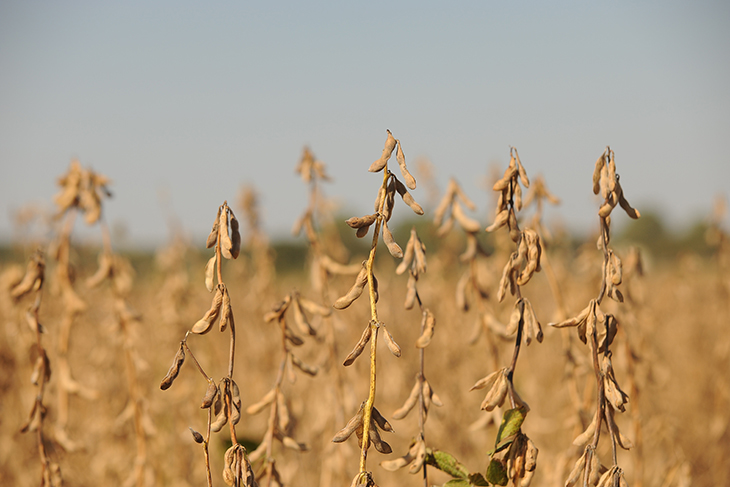
Soybean producers should be scouting for insect pests
Thursday, July 19, 2018
Reports have been coming into the Oklahoma Cooperative Extension Service about stink bug activity and pod-feeding caterpillars in soybean fields scattered across northeastern and north-central Oklahoma.
“As soybeans set seed and fill out, they definitely need protection from pod-feeding insects,” said Tom Royer, Oklahoma State University Cooperative Extension Integrated Pest Management coordinator. “These pests can cause significant losses to soybean yield.”
The most common pod-feeding caterpillar is the corn earworm, also known as the soybean podworm or the cotton bollworm. As the insects also are a pest of corn and cotton, they can be quite prevalent at times.
“Newly hatched caterpillars measure 1.5 millimeters long, with a translucent, yellowish white body,” Royer said. “Eventually, these caterpillars will vary considerably in color, but are commonly green, yellowish or black with noticeable longitudinal cream bands and an orange head capsule. They reach more than 1.5 inches in length when fully grown.”
Corn earworms have five pairs of prolegs, four pairs on the abdomen and one pair at the anal end. They are often found in flower clusters when small but move to leaves and pods as they get larger.
Another pod-feeder to watch out for is the stink bug. Several species will attack soybean fields, including the green, southern green and brown stink bug. Adult stink bugs are shield-shaped with a large triangular scutellum near the shoulder region. They are brown or green in color and are about three-eighths to five-eighths of an inch in length.
Stink bug eggs are barrel shaped and laid in clusters of 25 to 100, mostly on the underside of leaves. Eggs may be yellow, white or green but will turn to pink or darker as the nymphs near their time of hatching. Nymphs vary in color, depending on their age and species.
“Some are quite colorful, with black, white and pink markings on their body,” Royer said "They damage stems and pods, sucking the juices out of the pods, and cause pod drop, yield loss and reduced seed quality. Damage from stink bugs can be similar to damage from drought so make sure to sample and confirm their presence in the field.”
Grasshoppers also will feed on soybean pods, often chewing through the pod into the seed. Two common species are the differential and red-legged grasshoppers. Grasshopper eggs are typically laid in undisturbed areas, such as road ditches or no-till fields.
“When grasshoppers hatch, they are not mobile but begin to wander as they get older, and they eat more foliage,” Royer said. “Grasshoppers cause maximum damage once they become adults, and are more difficult to control because they are larger and can fly to new areas for feeding.”
Start by scouting the field
Soybean fields planted in rows can be scouted by shaking plants over a drop cloth or shake sheet.
“The plant-shaking method is a useful tool for weekly surveys in soybeans after the beans obtain a foot in height,” said Josh Lofton, OSU Cooperative Extension cropping systems specialist.
The equipment needed for this method consists of a piece of white or dark cloth measuring 24 inches by 42 inches. Each end of the cloth is stapled to a thin strip of wood, approximately a half inch to 1-inch wide and 24 inches in length.
To begin the survey, select a site at random in the field, kneel between the two rows, and unroll the cloth from one row over to the opposite row. Extend each arm forward parallel with the row on either side and vigorously shake the vines over the cloth.
“Your arms, from your elbows to your fingertips, will allow you to sample approximately 1.5 row-feet of plants on each side of the row,” Lofton said. “Thus 3 row-feet may be sampled at each site.”
Count the insects that fall to the cloth. Repeat this process for 10 sites per 50 acres. Infestations are characterized as to the number of various species per 30 row-feet.
“Another useful method for scouting seedling and broadcast beans is the sweep net method,” Royer said. “Make 10 consecutive sweeps – swinging the net from side to side 180 degrees across the body, one swing per step – with a standard 15-inch diameter sweep net while walking through the field.”
After 10 successive sweeps, remove the insects from the net, identify and count them. Repeat this procedure five times for 50 sweeps and compare counts with economic thresholds established for individual pests.
The thresholds for each of these pests during pod set and pod fill are as follows:
- Corn earworms, two per foot of row;
- Stink bugs: 1 per foot of row; and
- Grasshoppers: 5 percent to 10 percent of pods are damaged and grasshoppers are present.
Treatment guidelines for soybean insects sampled with a sweep net are as follows:
- Corn earworms, three to four per sweep;
- Stink bugs, one to two per sweep; and
- For other foliage feeders, use a threshold of 30 percent defoliation before first bloom and 15 percent thereafter.
Royer and Lofton said there are numerous insecticides registered for pod-feeding insect control.
“Soybean producers should contact their OSU Cooperative Extension county office for assistance and additional information about control options,” Royer said. “County Extension offices are typically listed under ‘county government’ in local directories.”
The Oklahoma Cooperative Extension Service is one of two state agencies administered by OSU’s Division of Agricultural Sciences and Natural Resources, and is a key part of the university’s state and federally mandated teaching, research and Extension land-grant mission.
